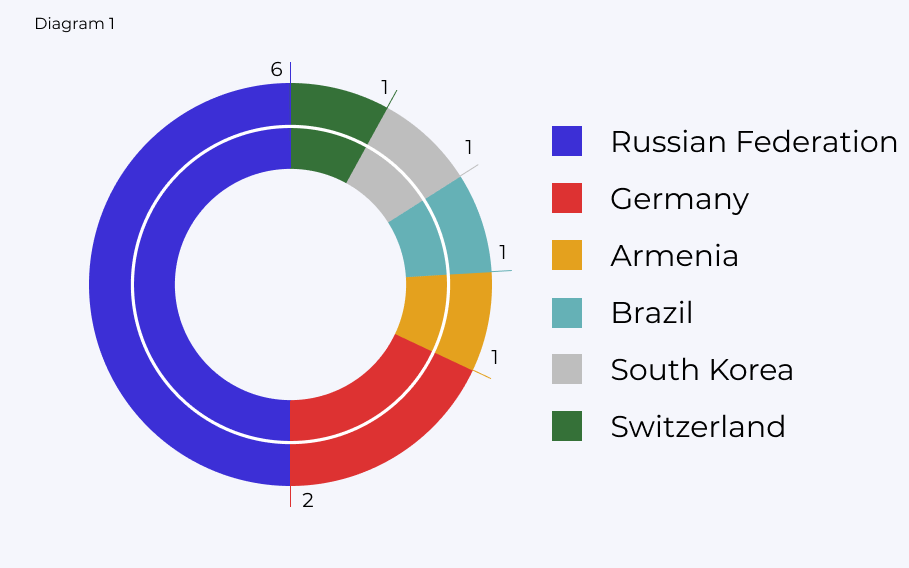Oppositions and Appeals against Decisions of the Eurasian Patent Office
In 2022, the Eurasian Patent Office received nine oppositions and appeals, including
- one opposition against the grant of a Eurasian patent under the administrative revocation procedure,
- four appeals against the refusal to grant Eurasian patents, and
- four appeals against the refusal to grant term extension to Eurasian patents.
Within the specified period, one appeal was received against the decision taken on the opposition to granted Eurasian patent filed under the administrative revocation procedure.
Table 1 presents information on the oppositions and appeals received over the past five years.
Table 1
|
Oppositions and appeals |
2018 |
2019 |
2020 |
2021 |
2022 |
|
against patent grants |
3 |
3 |
2 |
3 |
1 |
|
against refusal to grant patents |
1 |
1 |
2 |
4 |
4 |
|
against refusal of patent term extensions |
1 |
- |
3 |
5 |
4 |
|
Total |
5 |
4 |
7 |
12 |
9 |
In 2022, the Eurasian Patent Office examined nine oppositions and appeals, including
- two opposition against the grant of Eurasian patents under the administrative revocation procedure,
- four appeals against the refusal to grant Eurasian patents, and
- three appeals against the refusal to grant term extension to Eurasian patents.
Three subsequent appeals were also examined, including
- two appeals against the first instance decisions on appealed refusals to grant Eurasian patents, and
- one appeal against the decision taken on the opposition filed under the administrative revocation procedure.
The general trend of recent years continued in 2022, reflecting a low number of oppositions received by the Eurasian Patent Office under the administrative revocation procedure (0.04 per cent of the total number of patents granted per year).
Companies of the Russian Federation are the most active in filing oppositions under the administrative revocation procedure. Diagram 1 shows the information on the activity of companies from various countries in filing oppositions over the past five years (from 2018 to 2022).

In this, the most often opposed Eurasian patents under the administrative revocation procedure are those owned by rights holders from the USA. This is due to the fact that companies from the USA actively use the Eurasian patent system and are in leading position on the number of Eurasian patents. Diagram 2 presents information on the territorial affiliation of owners of Eurasian patents opposed under the administrative revocation procedure over the past five years (from 2018 to 2022).

The Eurasian patents opposed under the administrative revocation procedure were in the fields of chemistry, biotechnology, mechanics, pharmaceuticals, and food industry (presented in Diagram 3).

Table 2 presents information on the results of the examination of oppositions under the administrative revocation procedure on the basis of decisions entered into force over the past five years (from 2018 to 2022).
Table 2
|
Oppositions against the grant of Eurasian patents |
Revocation of Eurasian patent |
Eurasian patent maintained in amended form |
Opposition rejected |
Proceedings discontinued |
|
9 |
1 |
3 |
4 |
1 |
|
11.1 per cent |
33.3 per cent |
44.5 per cent |
11.1 per cent |
At the same time, in 2022 amendments were introduced to the Patent Regulations, according to which the time limits for filing oppositions under the administrative revocation procedure for Eurasian patents was extended from six months to nine months. This expands the possibility for third parties to oppose the granting of Eurasian patents directly to the EAPO.
In 2022, the activity of applicants in exercising their right to appeal examination decisions on the refusal to grant Eurasian patents returned to its annual average. Table 3 presents statistical data for the past five years.
Table 3
|
Year |
2018 |
2019 |
2020 |
2021 |
2022 |
|
Percentage of appealed decisions of refusal to grant patents |
11.1 |
11.1 |
16.7 |
50 |
18.2 |
Table 4 presents information on the results of the examination of appeals filed in accordance with Rule 48 of the Patent Regulations (based on decisions entered into force) over the past five years (from 2018 to 2022).
Table 4
|
Appeals |
Total |
Satisfied |
Rejected |
Proceedings discontinued |
|
against decisions of refusal to grant patents |
9 |
3 |
6 |
- |
|
33.33 per cent |
66.67 per cent |
0 per cent |
||
|
against decisions of refusal of patent term extensions |
10 |
8 |
1 |
1 |
|
80 per cent |
10 per cent |
10 per cent |
As follows from table 4, appeals against decisions of refusal to grant Eurasian patents are mostly rejected, which is evidence of the validity of decisions taken by the experts collegium, which generally shows the advantages of the collegial taking decisions based on the substantive examination of Eurasian applications. At the same time, the majority of appeals against decisions refusing the Eurasian patent term extensions are satisfied. This is due to the fact that, in filing such appeals, patent owners more carefully prepare the package of documentation to substantiate their rights to extend the patent term.
Generally, the results of the examination of appeals against the EAPO’s decisions are an indicative of the effectiveness of the mechanism set forth by the Rule 48 of the Patent Regulations for use by applicants and patent owners.